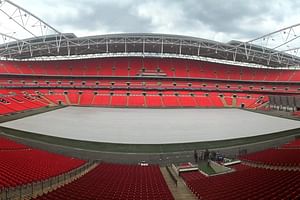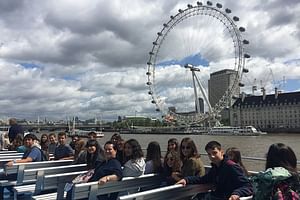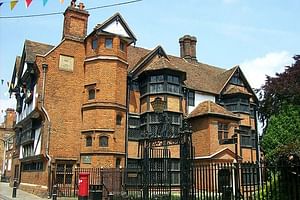-
Christ Church is one of the famous colleges in Oxford. The School of British Prime Ministers of all times was founded by Cardinal Thomas Wolsey, Cardinal and statesman of Henry VIII. The Chapel of the...
Christ Church is one of the famous colleges in Oxford. The School of British Prime Ministers of all times was founded by Cardinal Thomas Wolsey, Cardinal and statesman of Henry VIII. The Chapel of the College is doubled as the Cathedral of the city. The Grand Hall of the Harry Potter was filmed in three different spots. On the walls there are portraits of alumni–Prime Ministers, churchmen and philosophers; and Alice in Wonderland writer Lewis Carroll was teaching at the university. Christ Church has a number of architecturally significant buildings including Tom Tower (proudly designed by Sir Christopher Wren an Oxford professor, architect, inventor, astronomer and physicist) Tom Quad (the largest quadrangle in Oxford), and the Great Dining Hall which was also the seat of the parliament assembled by King Charles I during the English Civil War. Our APTG qualified blue badge tourist guides will tell you all interesting stories about Christ Church.
-
Yes, Alice is in Wonderland is real. In the Victorian era, its customers included Alice Liddell, daughter of Henry Liddell, who was Dean of Christ Church, Oxford, which is opposite the shop. Alice, wh...
Yes, Alice is in Wonderland is real. In the Victorian era, its customers included Alice Liddell, daughter of Henry Liddell, who was Dean of Christ Church, Oxford, which is opposite the shop. Alice, who used to buy sweets at the shop, was the inspiration for Lewis Carroll's Alice's Adventures in Wonderland and Through the Looking-Glass. We are talking about one of the most famous little shops in the world is right up there, just across the road from Christ Church College. The Alice’s Shop in Oxford is world-famous because the shop itself was written into the Alice adventures over 150 years ago. The small shop was dubbed “Alice’s Shop” locally as soon as the stories became well known, even as it continued as a grocery and sweet shop. Since the mid-60s, the shop began to sell Alice in Wonderland souvenirs. The Shop is now a treasure trove of Alice in Wonderland themed gifts, souvenirs and memorabilia. Alice’s Shop is one of the most tangible links to an entire episode in the Alice in Wonderland adventures and offers lovers of the stories a moment of intimate connection with the World of Alice as well as an insight into Carroll’s creation. The story is as sweet as candies in the store. Wanna shop?
-
The name "Carfax" derives from the Latin quadrifurcus via the French carrefour, both of which mean "crossroads". The tower is located in the centre of Oxford's shopping area since the medieval times. ...
The name "Carfax" derives from the Latin quadrifurcus via the French carrefour, both of which mean "crossroads". The tower is located in the centre of Oxford's shopping area since the medieval times. This 6 bells tower is all that remains of the 14th-century Church of St Martin. The Carfax Tower, also known as St. Martin's Tower (it is the remaining part of what was the City Church of St. Martin of Tours) is a prominent landmark and provides a look-out over the town. the Mayor and Corporation were expected to worship, between about 1122 and 1896, when the main part of the church was demolished to make more room for road traffic. In 1896 the City Church was moved to All Saints Church in the High Street. The tower is 74 feet (23 m) tall, and no building in central Oxford may be built higher than it.
-
Oxford Covered Market features more than 50 traders selling fresh produce, gifts, fashion, flowers and jewellery, and provides a unique showcase for the very best in local crafts, food and drink. The ...
Oxford Covered Market features more than 50 traders selling fresh produce, gifts, fashion, flowers and jewellery, and provides a unique showcase for the very best in local crafts, food and drink. The majority of the businesses are independent and with some going back generations. Oxford Covered Market, which was designed by Magdalen Bridge architect John Gwynn, first opened as a market for meat, fish, vegetables and herbs on 1 November 1774. It was then enlarged several times, rebuilt and fully roofed over during the 19th century. Original iron roof supports can easily be seen even today. Iron bars projecting from shop fronts that date from the 19th century and were used to hang meat. The Covered Market has been in continual use as a market for almost 250 years. Fancy a cup of traditional English tea with homemade cookies in this charming atmosphere? Just follow Tourope UK's APTG qualified blue badge tourist guides.
-
English Palladium Style with its stylish Cotswold stone, Radcliffe Camera is completed in 1737, this domed classical building forms the hub of architectural Oxford and is considered one of England's e...
English Palladium Style with its stylish Cotswold stone, Radcliffe Camera is completed in 1737, this domed classical building forms the hub of architectural Oxford and is considered one of England's earliest examples of around library. Funded by Dr John Radcliffe, designed by James Gibbs and built between 1737–48, this grand circular building in the middle of Radcliffe Square is an iconic landmark in Oxford and a working library. The domed classical building is considered to be one of England's earliest examples of around the library. This lovely masterpiece is actually a gift from Dr Radcliffe showing his appreciation to the town where he became famous.
-
The Bodleian Library is a working library which forms part of the University of Oxford. It is housed in a remarkable group of buildings which forms the historic heart of the University, and you can ex...
The Bodleian Library is a working library which forms part of the University of Oxford. It is housed in a remarkable group of buildings which forms the historic heart of the University, and you can explore the quadrangles of these magnificent structures at no charge. Some of the buildings, such as the University’s oldest teaching and examination room, The Divinity School (built 1427-88). Here you will discover more of the University’s fascinating history by Tourope UK's APTG qualified blue badge tourist guides telling behind the scenes in the Library, including its oldest research library, dating from 1602-20. You will marvel at 5 basic orders of the architecture of columns such as Doric, Ionic, Corinthian, Tucson and Composite.
-
The main buildings at Hertford College are linked together by a corridor called the "Bridge of Sighs," built-in 1913-14 and named after the Ponte Dei Sospiri in Venice. The Bridge of Sighs lies right ...
The main buildings at Hertford College are linked together by a corridor called the "Bridge of Sighs," built-in 1913-14 and named after the Ponte Dei Sospiri in Venice. The Bridge of Sighs lies right opposite the entrance to the Bodleian Library, famous for its similarity to the Bridge of Sighs in Venice, has never intended to be a replica of the Venetian bridge, and instead, it bears a closer resemblance to the Rialto Bridge in the same city. Nevertheless, the bridge provides a popular photo opportunity for tourists and newcomers. Just pay attention to our guide why we call the bridge as "Bridge of Sighs"
-
Built-in 1712 by the Oxford University Press for the University's printing, the building is now part of the Bodleian Library. It was built to house the Oxford University Press, which had previously be...
Built-in 1712 by the Oxford University Press for the University's printing, the building is now part of the Bodleian Library. It was built to house the Oxford University Press, which had previously been occupying a large room over the ceiling of the Sheldonian Theatre. It owes it name to the fact that it was partly paid for by the profits from the History of the Great Rebellion by Lord Clarendon, whose son presented the University with its copyright. It was known as “The Printing House” until the University Press moved to Walton Street in 1832. Today the building is used as an international exam centre.
-
The Sheldonian Theatre, an exquisite Grade I listed building situated in Oxford's city centre, is the official ceremonial hall of Oxford University. The Theatre is a popular tourist attraction particu...
The Sheldonian Theatre, an exquisite Grade I listed building situated in Oxford's city centre, is the official ceremonial hall of Oxford University. The Theatre is a popular tourist attraction particular because it offers one of the best indoor panoramic views of Oxford's famous skyline from its Cupola. It was designed by Sir Christopher Wren and built between 1664 and 1669. Learn about how the University was formed, how long it's been in existence and the secrets of its past by Tourope UK's APTG qualified blue badge tourist guides. Next to the Sheldonian Theatre, we will also visit Divinity School. You will be amazed at the Divinity School’s intricate ceiling patterns and gorgeous tall windows. On your visit make sure to take a sit on a bench and imagine oral exams taking places within those magnificent walls. The Divinity School is a medieval building and room in the Perpendicular style characterised by its rich ornamentation and tracery. The building, which belongs to the University of Oxford, is attached to the Bodleian Library.
Designed between 1423 and 1488 specifically for lectures, oral exams and discussions on theology, was almost ‘certainly the building that popularised Tudor arches’. The building was also used during the very first series of the Harry Potter movie.
-
With its medieval bridge, old stone houses and attractive Tudor and Georgian frontages, Burford is justifiably called one of the most picturesque towns in England. This bucolic town was originally a f...
With its medieval bridge, old stone houses and attractive Tudor and Georgian frontages, Burford is justifiably called one of the most picturesque towns in England. This bucolic town was originally a fortified Anglo-Saxon ford which later grew to be an important regional crossroads and wealthy wool town. Although Burford is in Oxfordshire, this pretty town is popularly known as "The Gateway to the Cotswolds". Burford’s famous High Street sweeps downhill towards the River Windrush, its three-arched medieval bridge and its impressive church, both sides of the street flanked by an unbroken line of ancient houses and shops. Little has changed over the centuries, Burford is popular with visitors, both for its beauty and history but also for its shopping, especially antiques, and for the wide variety of places to eat, with restaurants, pubs and teashops. Here you can stay in a hotel frequented by King Charles I and Nell Gwynn. England’s oldest pharmacy, a chemist’s since 1734 is also in Burford. Needless to say the dairy products are just tempting in artisan shops.
-
Welcome to the charming English village in the heart of England. Regularly voted one of the prettiest villages in England, Bourton-on-the-Water has a unique appeal to visitors and residents alike. Wit...
Welcome to the charming English village in the heart of England. Regularly voted one of the prettiest villages in England, Bourton-on-the-Water has a unique appeal to visitors and residents alike. With plenty to see and do, Bourton-on-the-Water offers a wealth of attractions and shops, restaurants and tea rooms, or simply for the visitors to enjoy some tranquil time in this lovely town. No wonder the area is nominated as Area of Outstanding Natural Beauty. This popular village is often referred to as the ‘Venice of the Cotswolds’ because of the attractive little bridges that cross the gently flowing River Windrush, which runs through the centre of the village. Bourton has a charm all of its own at any time of the year.
-
The famous Bourton-on-the-Water Model Village is the only grade II listed model village in the country. The Model Village is a one-ninth scale replica of the heart of the beautiful Cotswold village of...
The famous Bourton-on-the-Water Model Village is the only grade II listed model village in the country. The Model Village is a one-ninth scale replica of the heart of the beautiful Cotswold village of Bourton-on-the-Water, containing all the buildings from the Old Water Mill (now the Car Museum) down to the Old New Inn and the ford, all built-in Cotswold stone. In the Model Village, you become a giant as you tower above the miniature stone houses. Walk alongside the river Windrush and cross its miniature bridges. Enjoy the miniature gardens complete with flowers and miniature trees. Listen to the choirs singing in the churches, investigate the local shops, and find the model of the Model Village. You will adore this pretty town.
-
Just off the famous Fosse Way between Bourton and Stow on the Wold, a pretty village greets its visitors. In habited 1000 years, the village is built on both banks of the River Eye, a slow-moving stre...
Just off the famous Fosse Way between Bourton and Stow on the Wold, a pretty village greets its visitors. In habited 1000 years, the village is built on both banks of the River Eye, a slow-moving stream crossed by two footbridges, which also flows through Upper Slaughter. At the west end of the village, there is a pretty 19th-century water mill with an undershot waterwheel and a chimney for additional steam power. There is a ford where the river widens in the village and several small stone footbridges join the two sides of the community. While the mill is built of red brick most of the 16th and 17th-century homes in the village use Cotswold limestone and are adorned with mullioned windows and often with other embellishments such as projecting gables. The name of the village derives from the Old English term "slough" meaning "wetland" and you will adore this wetland.
-
Stow on the wold, where the wind blows cold!... This pretty ancient sheep market town is today's delightful shopping town and along with Moreton in Marsh, perhaps the best known of the small Cotswolds...
Stow on the wold, where the wind blows cold!... This pretty ancient sheep market town is today's delightful shopping town and along with Moreton in Marsh, perhaps the best known of the small Cotswolds towns. Stow-on-the-Wold is the highest of the Cotswold towns standing exposed on 800 feet high Stow Hill at a junction of seven major roads, including the Roman Fosse Way. At the height of the Cotswold wool industry the town was famous for its huge annual fairs where as many as 20,000 sheep were sold at one time. The vast Market Square testifies to the towns former importance. At one end stands the ancient cross, and at the other, the town stocks shaded between an old elm tree. Around the square, the visitor is faced with an elegant array of Cotswold town houses and shops. Stow is an important shopping area and has many fine Antique shops, Art galleries, Gifts and Crafts and is a centre for Walking the Cotswolds countryside where you can admire.




























